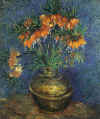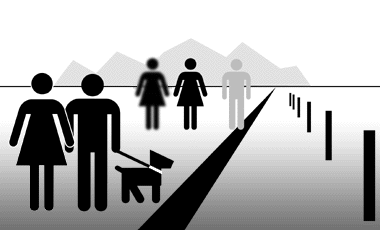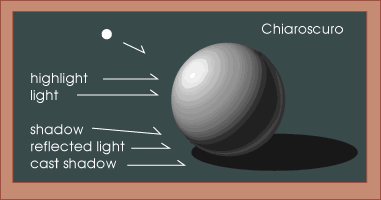
 Vincent Van Gogh Fritillaries 1800's
Vincent Van Gogh Fritillaries 1800's
Depth
The apparent distance from front to back or near to far in an artwork.
When depth refers to an object's smallest dimension, then this distance can also be called its thickness.
•Warm
(yellow, orange or red) colors appear closer
•Cool
(blue, green, or violet) colors appear further away

 Vincent Van Gogh Fritillaries 1800's
Vincent Van Gogh Fritillaries 1800's

Texture
If the actual distance of two objects is unknown, the object that is clearer and more detailed will appear closer to an observer.
A regular structure, e.g. a tiled floor, appears to show smaller structures with increasing distance.
Texture Gradient - all surfaces have a texture, and as the surface goes into the distance, it becomes smoother and finer.
Relative height
Relative height of an image is another cue if one object is lower in the picture plane than another it appears to be nearer the observer.
Relative Size
Over the years, we have learned that objects on our planet change size slowly, if at all. In other words, when the image of an object gets larger on the retina, we interpret that as a distance cue (closer). Conversely, when the image on the retina gets smaller, we interpret that as the object becoming farther away. So, if we are in a tall building looking down at some people, we do not say, "Look at those teensy people just outside the window." Rather, we say, "Look at those normal-sized people far away." Our knowledge of the world, then, dictates our perceptions.
Overlapping
Objects that are in front of other objects may partially block our view of the rearmost object. Because we know what the object should look like, and because we see only part of it, we interpret the obstructed object as being farther away.
Any shape that overlaps another seems to be in front of it.
 Marcel Duchamp Apolinere
Enameled 1965
Marcel Duchamp Apolinere
Enameled 1965
Brightness
It has been proved that the brighter of two otherwise identical objects is perceived as nearer. There is no satisfactory physical, geometric or photometric explanation for this effect; however, an interpretation is our experience when working with a source of light (e.g. a torch) in dark environment.
Atmospheric Haze: Aerial Perspective
The perception of depth in nature can be enhanced by the appearance of atmospheric haze. Although this haze is most commonly humidity (or cloudiness), it could be rain or snow, smoke, or any other kind of vapor. Aerial perspective is the portrayal of that atmospheric haze -- one means to adding to an illusion of depth in depicting space on a flat surface. It is achieved by using less focus, along with bluer, lighter, and duller hues for the distant spaces and objects depicted in a picture.
The atmosphere scatters light. That is what causes the sky to be blue.
The short or blue wavelengths of light are most easily scattered by the particles in the atmosphere which is why the sky is blue, although scattering does occur to some extent for other wavelengths of light.
The scattering occurs for all light regardless of the direction that the light comes from (there is nothing special about sunlight that causes it to be scattered more). Thus, light coming from any distant object should have some of its light scattered. That will have two effects on the light reaching our eyes:
Colors
fade and appear less distinct and blend the further away.
since blue is scattered more, more distant objects should appear bluish,
since not all of the light is traveling in a straight line to us, then more distant objects should appear a bit fuzzy and not as in a sharp of a focus.
http://vista.cira.colostate.edu/improve/Tools/win_haze.htm
Chiaroscuro (kee-ahr'oh-scyoo"roh)
Chiaroscuro is a method for applying value to a two-dimensional piece of artwork to create the illusion of a three-dimensional solid form. This way of working was devised during the Italian Renaissance and was used by artists such as Leonardo da Vinci and Raphael. In this system, if light is coming in from one predetermined direction, then light and shadow will conform to a set of rules.

Georges Seurat Embroidery;
The Artist's Mother, 1882–83
Conté crayon; 12 1/4 x 9 1/2 in. (31.2 x 24 cm)
Vija
Celmins
Untitled (Ocean), 1969
Graphite on acrylic ground on wove paper
14 x 18 3/4"
Vija
Celmins
Untitled (Long Ocean 3), 1979
Graphite

 Vija Celmins Untitled (Web
2 & 3) 2002
Vija Celmins Untitled (Web
2 & 3) 2002
one-color aquatint with burnishing, scraping, and drypoint on Hahnemuhle
Copperplate paper 20 1/8 x 24 inches

Foreshortening
Foreshortening is the process of applying linear perspective to the figure. It is a way to create great depth and drama to a image.
 Andrea
Mantegna Dead Christ, 1480-90, tempera on canvas; Milan, Brera Pinacoteca; cm 68
x 81
Andrea
Mantegna Dead Christ, 1480-90, tempera on canvas; Milan, Brera Pinacoteca; cm 68
x 81

By placing the images in a vertical band while progressively reducing the size, width, and the interval between each, we can immediately experience the strong sense of movement into the picture plane that results from a coordinated manipulation of foreshortening, clock angles, and reduction in size.